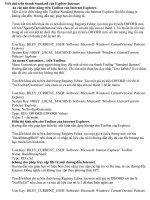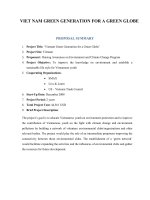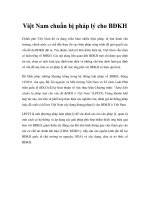Tài liệu viết UMAT Abaqus
Bạn đang xem bản rút gọn của tài liệu. Xem và tải ngay bản đầy đủ của tài liệu tại đây (685.04 KB, 117 trang )
ABAQUS
Lecture 6
Writing a UMAT or VUMAT
Overview
• Motivation
• Steps Required in Writing a UMAT or VUMAT
• UMAT Interface
• Examples
• VUMAT Interface
• Examples
7/01
Writing User Subroutines with ABAQUS
L6.1
ABAQUS
Overview
Overview
• ABAQUS/Standard and ABAQUS/Explicit have interfaces that allow
the user to implement general constitutive equations.
– In ABAQUS/Standard the user-defined material model is
implemented in user subroutine UMAT.
– In ABAQUS/Explicit the user-defined material model is
implemented in user subroutine VUMAT.
• Use UMAT and VUMAT when none of the existing material models
included in the ABAQUS material library accurately represents the
behavior of the material to be modeled.
7/01
Writing User Subroutines with ABAQUS
L6.2
ABAQUS
Overview
• These interfaces make it possible to define any (proprietary)
constitutive model of arbitrary complexity.
• User-defined material models can be used with any ABAQUS
structural element type.
• Multiple user materials can be implemented in a single UMAT or VUMAT
routine and can be used together.
In this lecture the implementation of material models in UMAT or VUMAT
will be discussed and illustrated with a number of examples.
7/01
Writing User Subroutines with ABAQUS
L6.3
ABAQUS
Motivation
Motivation
• Proper testing of advanced constitutive models to simulate
experimental results often requires complex finite element models.
– Advanced structural elements
– Complex loading conditions
– Thermomechanical loading
– Contact and friction conditions
– Static and dynamic analysis
7/01
Writing User Subroutines with ABAQUS
L6.4
ABAQUS
Motivation
• Special analysis problems occur if the constitutive model simulates
material instabilities and localization phenomena.
– Special solution techniques are required for quasi-static analysis.
– Robust element formulations should be available.
– Explicit dynamic solution algorithms with robust, vectorized
contact algorithms are desired.
• In addition, robust features are required to present and visualize the
results.
– Contour and path plots of state variables.
– X–Y plots.
– Tabulated results.
7/01
Writing User Subroutines with ABAQUS
L6.5
ABAQUS
Motivation
• The material model developer should be concerned only with the
development of the material model and not the development and
maintenance of the FE software.
– Developments unrelated to material modeling
– Porting problems with new systems
– Long-term program maintenance of user-developed code
7/01
Writing User Subroutines with ABAQUS
L6.6
ABAQUS
Motivation
• “Finite Element Modelling of the Damage Process in Ice,”
R. F. McKenna, I. J. Jordaan, and J. Xiao, ABAQUS Users’ Conference
Proceedings, 1990.
7/01
Writing User Subroutines with ABAQUS
L6.7
ABAQUS
Motivation
• “The Numerical Simulation of Excavations in Deep Level Mining,”
M. F. Snyman, G. P. Mitchell, and J. B. Martin, ABAQUS Users’
Conference Proceedings, 1991.
7/01
Writing User Subroutines with ABAQUS
L6.8
ABAQUS
Motivation
• “Combined Micromechanical and Structural Finite Element Analysis of
Laminated Composites,” R. M. HajAli, D. A. Pecknold, and M. F.
Ahmad, ABAQUS Users’ Conference Proceedings, 1993.
7/01
Writing User Subroutines with ABAQUS
L6.9
ABAQUS
Motivation
• “Deformation Processing of Metal Powders: Cold and Hot Isostatic
Pressing,” R. M. Govindarajan and N. Aravas, private communication,
1993.
7/01
Writing User Subroutines with ABAQUS
L6.10
ABAQUS
Motivation
• “Macroscopic Shape Change and Evolution of Crystallographic
Texture in Pre-textured FCC Metals,” S. R. Kalidindi and Anand, Acta
Metallurgica, 1993.
7/01
Writing User Subroutines with ABAQUS
L6.11
ABAQUS
Steps Required in Writing a UMAT or VUMAT
Steps Required in Writing a UMAT or VUMAT
• Proper definition of the constitutive equation, which requires one of the
following:
– Explicit definition of stress (Cauchy stress for large-strain
applications)
– Definition of the stress rate only (in corotational framework)
• Furthermore, it is likely to require:
– Definition of dependence on time, temperature, or field variables
– Definition of internal state variables, either explicitly or in rate
form
7/01
Writing User Subroutines with ABAQUS
L6.12
ABAQUS
Steps Required in Writing a UMAT or VUMAT
• Transformation of the constitutive rate equation into an incremental
equation using a suitable integration procedure:
– Forward Euler (explicit integration)
– Backward Euler (implicit integration)
– Midpoint method
7/01
Writing User Subroutines with ABAQUS
L6.13
ABAQUS
Steps Required in Writing a UMAT or VUMAT
This is the hard part! Forward Euler (explicit) integration methods are
simple but have a stability limit,
∆ε < ∆ε stab,
where ∆ε stab is usually less than the elastic strain magnitude.
– For explicit integration the time increment must be controlled.
– For implicit or midpoint integration the algorithm is more
complicated and often requires local iteration. However, there is
usually no stability limit.
– An incremental expression for the internal state variables must also
be obtained.
7/01
Writing User Subroutines with ABAQUS
L6.14
ABAQUS
Steps Required in Writing a UMAT or VUMAT
• Calculation of the (consistent) Jacobian (required for
ABAQUS/Standard UMAT only).
• For small-deformation problems (e.g., linear elasticity) or
large-deformation problems with small volume changes (e.g., metal
plasticity), the consistent Jacobian is
∂∆σ
C = ---------- ,
∂∆ε
where ∆σ is the increment in (Cauchy) stress and ∆ε is the
increment in strain. (In finite-strain problems, ε is an
approximation to the logarithmic strain.)
– This matrix may be nonsymmetric as a result of the constitutive
equation or integration procedure.
– The Jacobian is often approximated such that a loss of quadratic
convergence may occur.
7/01
Writing User Subroutines with ABAQUS
L6.15
ABAQUS
Steps Required in Writing a UMAT or VUMAT
– It is easily calculated for forward integration methods (usually the
elasticity matrix).
– If large deformations with large volume changes are considered
(e.g., pressure-dependent plasticity), the exact form of the
consistent Jacobian
1 ∂∆ ( Jσ )
C = --- -----------------J ∂∆ε
should be used to ensure rapid convergence. Here, J is the
determinant of the deformation gradient.
7/01
Writing User Subroutines with ABAQUS
L6.16
ABAQUS
Steps Required in Writing a UMAT or VUMAT
• Hyperelastic constitutive equations
– Total-form constitutive equations relating the Cauchy stress σ and
the deformation gradient F are commonly used to model, for
example, rubber elasticity.
– In this case, the consistent Jacobian is defined through:
δ ( Jσ ) = JC : δD ,
where J = F , C is the material Jacobian, and δD is the virtual
rate of deformation, defined as
δD = sym ( δF ⋅ F – 1 ) .
7/01
Writing User Subroutines with ABAQUS
L6.17
ABAQUS
Steps Required in Writing a UMAT or VUMAT
• Coding the UMAT or VUMAT:
– Follow FORTRAN 77 or C conventions.
– Make sure that the code can be vectorized (for VUMAT only, to be
discussed later).
– Make sure that all variables are defined and initialized properly.
– Use ABAQUS utility routines as required.
– Assign enough storage space for state variables with the
∗DEPVAR option.
7/01
Writing User Subroutines with ABAQUS
L6.18
ABAQUS
Steps Required in Writing a UMAT or VUMAT
• Verifying the UMAT or VUMAT with a small (one element) input file.
1. Run tests with all displacements prescribed to verify the
integration algorithm for stresses and state variables. Suggested
tests include:
– Uniaxial
– Uniaxial in oblique direction
– Uniaxial with finite rotation
– Finite shear
2. Run similar tests with load prescribed to verify the accuracy of the
Jacobian.
3. Compare test results with analytical solutions or standard
ABAQUS material models, if possible. If the above verification is
successful, apply to more complicated problems.
7/01
Writing User Subroutines with ABAQUS
L6.19
ABAQUS
UMAT Interface
UMAT Interface
• These input lines act as the interface to a UMAT in which isotropic
hardening plasticity is defined.
*MATERIAL, NAME=ISOPLAS
*USER MATERIAL, CONSTANTS=8, (UNSYMM)
30.E6, 0.3, 30.E3, 0., 40.E3, 0.1, 50.E3, 0.5
*DEPVAR
13
*INITIAL CONDITIONS, TYPE=SOLUTION
Data line to specify initial solution-dependent variables
*USER SUBROUTINES,(INPUT=file_name)
• The ∗USER MATERIAL option is used to input material constants for
the UMAT. The unsymmetric equation solution technique will be used if
the UNSYMM parameter is used.
7/01
Writing User Subroutines with ABAQUS
L6.20
ABAQUS
UMAT Interface
• The ∗DEPVAR option is used to allocate space at each material point
for solution-dependent state variables (SDVs).
• The ∗INITIAL CONDITIONS, TYPE=SOLUTION option is used to
initialize SDVs if they are starting at a nonzero value.
• Coding for the UMAT is supplied in a separate file. The UMAT is invoked
with the ABAQUS execution procedure, as follows:
abaqus job=... user=....
– The user subroutine must be invoked in a restarted analysis
because user subroutines are not saved on the restart file.
7/01
Writing User Subroutines with ABAQUS
L6.21
ABAQUS
UMAT Interface
• Additional notes:
– If a constant material Jacobian is used and no other nonlinearity is
present, reassembly can be avoided by invoking the quasi-Newton
method with the input line
*SOLUTION TECHNIQUE, REFORM KERNEL=n
– n is the number of iterations done without reassembly.
– This does not offer advantages if other nonlinearities (such as
contact changes) are present.
7/01
Writing User Subroutines with ABAQUS
L6.22
ABAQUS
UMAT Interface
• Solution-dependent state variables can be output with identifiers SDV1,
SDV2, etc. Contour, path, and X–Y plots of SDVs can be plotted in
ABAQUS/Viewer.
• Include only a single UMAT subroutine in the analysis. If more than one
material must be defined, test on the material name in UMAT and
branch.
7/01
Writing User Subroutines with ABAQUS
L6.23
ABAQUS
UMAT Interface
• The UMAT subroutine header is shown below:
SUBROUTINE UMAT(STRESS, STATEV, DDSDDE, SSE, SPD, SCD, RPL,
1 DDSDDT, DRPLDE, DRPLDT, STRAN, DSTRAN, TIME, DTIME, TEMP, DTEMP,
2 PREDEF, DPRED, CMNAME, NDI, NSHR, NTENS, NSTATV, PROPS, NPROPS,
3 COORDS, DROT, PNEWDT, CELENT, DFGRD0, DFGRD1, NOEL, NPT, LAYER,
4 KSPT, KSTEP, KINC)
C
INCLUDE ’ABA_PARAM.INC’
C
CHARACTER*8 CMNAME
C
DIMENSION STRESS(NTENS), STATEV(NSTATV), DDSDDE(NTENS, NTENS),
1 DDSDDT(NTENS), DRPLDE(NTENS), STRAN(NTENS), DSTRAN(NTENS),
2 PREDEF(1), DPRED(1), PROPS(NPROPS), COORDS(3), DROT(3, 3),
3 DFGRD0(3, 3), DFGRD1(3, 3)
– The include statement sets the proper precision for floating point
variables (REAL*8 on most machines).
– The material name, CMNAME, is an 8-byte character variable.
7/01
Writing User Subroutines with ABAQUS
L6.24
ABAQUS
UMAT Interface
UMAT Variables
• The following quantities are available in UMAT:
– Stress, strain, and SDVs at the start of the increment
– Strain increment, rotation increment, and deformation gradient at
the start and end of the increment
– Total and incremental values of time, temperature, and
user-defined field variables
– Material constants, material point position, and a characteristic
element length
– Element, integration point, and composite layer number (for shells
and layered solids)
– Current step and increment numbers
7/01
Writing User Subroutines with ABAQUS
L6.25








